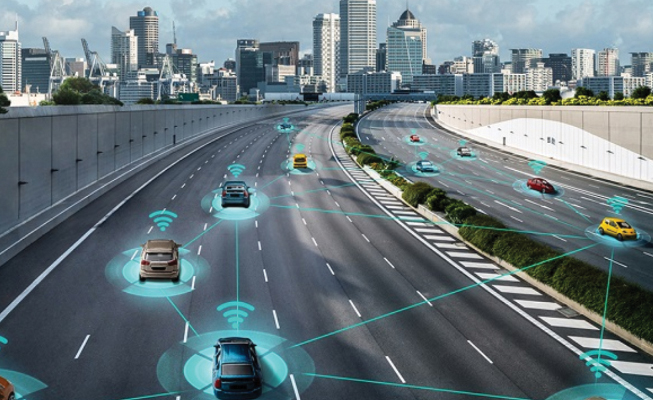As electric energy companies look to modernize their vehicles, the benefits of connected vehicles could make these technologies the new standard for fleet management. In fact, 86% of connected fleet operators already surveyed have reported a solid return on their investment in connected fleet technology within one year through reduced operational costs1.
Furthermore, connected fleets with advanced telematics technology today offer additional benefits in terms of managing and maintaining vehicles. Another study2 illustrated a 13% reduction in fuel costs for surveyed businesses, along with improvements to preventive maintenance. It also showed a 40% reduction in harsh braking, showing modifications to driving habits that could both contribute to parts' longevity and improve driver safety.
Large amounts of data are difficult to process
This means electric energy vehicle fleets, their insurance providers, maintenance and aftermarket companies are all looking to harness more of this intelligent telematics data. However, the amount of data produced every day keeps growing. As a result, these businesses have more data than ever at their disposal to help make informed business decisions. But, this vast amount of data brings in plenty of new challenges in capturing, digesting and analyzing the entirety of the data cost-effectively.
To truly be effective and useful, data must be tracked, managed, cleansed, secured and enriched throughout its journey to generate the right insights. Companies with electric energy fleets are turning to new processing capabilities to manage and make sense of this data.
Embedded systems technology has been the norm
Traditional telematics systems have relied upon embedded systems, which are devices designed to access, collect, analyze (in-vehicle) and control data in electronic equipment, to solve a set of problems. These embedded systems have been widely used, especially in household appliances and today the technology is growing in the use of analyzing vehicle data.
Why current solutions are not very efficient
The existing solution in the market is to use the low latency of 5G. Using AI and GPU acceleration on AWS Wavelength or Azure Edge Zone, vehicle OEMs can offload onboard vehicle processors to the cloud when feasible. This approach allows traffic between 5G devices and content or application servers hosted in Wavelength zones to bypass the internet, resulting in reduced variability and content loss.
To ensure optimum accuracy and richness of datasets, and to maximize usability, sensors embedded within the vehicles are used to collect the data and transmit it wirelessly, between vehicles and a central cloud authority, in near real-time. Depending on the use cases that are increasingly becoming real-time oriented such as roadside assistance, ADAS and active driver score and vehicle score reporting, the need for lower latency and high throughput have become much larger in focus for fleets, insurers and other companies leveraging the data.
However, while 5G solves this to a large extent, the cost incurred for the volume of this data being collected and transmitted to the cloud remains cost prohibitive. This makes it imperative to identify advanced embedded compute capability inside the car for edge processing to happen as efficiently as possible.
The rise of vehicle-to-cloud communication
To increase bandwidth efficiency and mitigate latency issues, it’s better to conduct critical data processing at the edge within the vehicle and only share event-related information to the cloud. In-vehicle edge computing has become critical to ensure that connected vehicles can function at scale, due to the applications and data being closer to the source, providing a quicker turnaround and drastically improving the system’s performance.
Technological advancements have made it possible for automotive embedded systems to communicate with sensors, within the vehicle as well as the cloud server, effectively and efficiently. Leveraging a distributed computing environment that optimizes data exchange as well as data storage, automotive IoT improves response times and saves bandwidth for a swift data experience. Integrating this architecture with a cloud-based platform further helps to create a robust, end-to-end communications system for cost-effective business decisions and efficient operations. Collectively, the edge cloud and embedded intelligence duo connect the edge devices (sensors embedded within the vehicle) to the IT infrastructure to make way for a new range of user-centric applications based on real-world environments.

This has a wide range of applications across verticals where resulting insights can be consumed and monetized by the OEMs. The most obvious use case is for aftermarket and vehicle maintenance where effective algorithms can analyze the health of the vehicle in near real-time to suggest remedies for impending vehicle failures across vehicle assets like engine, oil, battery, tires and so on. Fleets leveraging this data can have maintenance teams ready to perform service on a vehicle that returns in a far more efficient manner since much of the diagnostic work has been performed in real time.
Additionally, insurance and extended warranties can benefit by providing active driver behavior analysis so that training modules can be drawn up specifically to meet individual driver needs based on actual driving behavior history and analysis. For fleets, the active monitoring of both the vehicle and driver scores can enable reduced TCO (total cost of ownership) for fleet operators to reduce losses owing to pilferage, theft and negligence while again providing active training to the drivers.
Strong benefits in improving safety
One of the primary benefits of AI in connected cars is its ability to improve safety. By analyzing data from various sources, including traffic patterns, weather conditions and the behavior of other drivers, AI can help drivers make better decisions on the road, reducing the risk of accidents. AI can also be used to monitor drivers' behavior and alert them to potential risks, such as drowsiness or distracted driving. Unexpected things happening inside today’s vehicles can lead to accidents. Drivers can see something disturbing – a car accident, or an animal injured by a car – or do something distracting, such as spilling coffee or dropping a mobile phone. Emotion and activity detection can detect when this happens and take safety-related actions, such as going into autonomous mode briefly and slowing down until the driver can recover. If an emergency arises, even with an unconscious or incapacitated driver, cars should be able to call 911 or even drive them autonomously to the hospital. Driver inattention is critical since the vast majority of car accidents are due to human error. Understanding the driver’s cognitive state is crucial.
AI can also be used to improve health and well-being in connected vehicles. For example, AI-powered systems can monitor drivers' vital signs, such as heart rate and blood pressure, and alert them to potential health issues. AI can also be used to provide drivers with personalized recommendations for exercise and nutrition, helping them maintain a healthy lifestyle while on the road.
Overall improvements for health purposes
Another area where AI is having an impact on health, safety and well-being in connected cars is in the area of accessibility. AI-powered systems can be used to assist drivers with disabilities, providing them with information on accessible routes and parking spaces, as well as providing them with assistance in operating the vehicle.
Overall, the use of AI and data in connected cars is transforming the driving experience, improving safety and promoting health and well-being on the road. As AI technology continues to evolve, it is likely that we will see even more innovation in this space, making the connected car a safer and more enjoyable place to be.
Powering the future of fleet management
AI-powered analytics leveraging IoT, edge computing and the cloud are rapidly changing how fleet management is performed, making it more efficient and effective than ever. The ability of AI to analyze large amounts of information from telematics devices provides managers with valuable information to improve fleet efficiency, reduce costs and optimize productivity. From real-time analytics to driver safety management, AI is already changing the way fleets are managed.
The more datasets AI collects with OEM processing via the cloud, the better predictions it can make. This means safer, more intuitive automated vehicles in the future with more accurate routes and better real-time vehicle diagnostics.
1 https://www.globenewswire.com/news-release/2021/12/07/2347114/0/en/Survey-Highlights-Powerful-Results-Obtained-By-Using-Fleet-Technology.html
2 https://www.greencarcongress.com/2022/08/20220822-motive.html

Sumit Chauhan is co-founder and chief operating officer of Cerebrum X and has more than 24 years of experience in automotive, IoT, telecoms and healthcare. Chauhan has always played the leadership role that allowed him to manage a P&L of close to US $ 0.5B across various organizations, such as Aricent, Nokia and Harman, enriching their domestic as well as international business verticals. As co-founder of CerebrumX, he has applied his experience in the connected vehicle data domain to deliver the automotive industry with an AI-powered augmented deep learning platform (ADLP). Chuhan is also passionate about mentoring and guiding the next generation of entrepreneurs.







